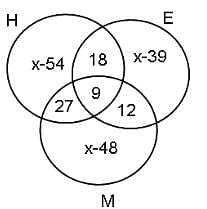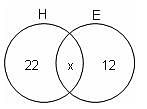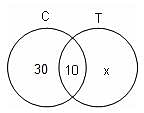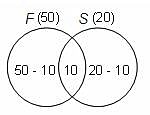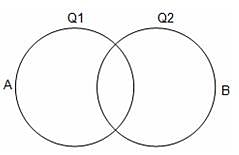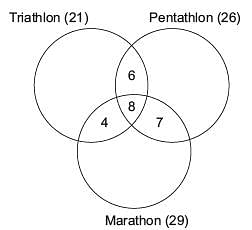Test Level 1: Set Theory - 2 - CAT MCQ
15 Questions MCQ Test Level-wise Tests for CAT - Test Level 1: Set Theory - 2
Directions: Study the following information and answer the question.
In Foodpur, where a person has to eat either vegetarian food or non-vegetarian food, there are 600 people who eat non-vegetarian food, 400 people who eat vegetarian food and 150 people who eat both. Of the people who eat non-vegetarian, there are 300 who eat mutton, 400 who eat chicken and 200 who eat both these types of meat.
Q. How many members of the city do not eat vegetarian food, but eat non-vegetarian food?
Directions: Study the following information and answer the question.
A newsagent sells the dailies Hindu, Express and Mail in equal number to 906 persons. 21 persons buy Express and Mail, 36 buy Hindu and Mail, 27 buy Hindu and Express, and buy 9 all the three dailies.
Q. The percentage of people buying Hindu or Express but not Mail is
| 1 Crore+ students have signed up on EduRev. Have you? Download the App |
In a group of 45 students, 22 can speak Hindi only and 12 can speak English only. How many students can speak both Hindi and English?
In a group of 26 persons, 8 take tea but not coffee and 8 take tea and coffee both. How many take coffee but not tea?
At a meeting of 100 people, there were 23 Indian men and 29 Indian women. Of these Indians, 4 were dentists and 24 were either men or dentists. Assume that there were no foreign dentists. How many foreigners attended the meeting?
Let A and B have 3 and 6 elements, respectively. What can be the minimum number of elements in A ∪ B?
In a group of 65 people, 40 like cricket, 10 like both cricket and tennis. Each one likes at least one sport out of cricket and tennis.
How many people like only tennis and not cricket?
In a committee, 50 people speak French, 20 speak Spanish and 10 speak both Spanish and French. How many speak at least one of the two languages?
In a community, 56% of the total families use mixers and 66% of the total use air conditioners.
If the total number of families is 300, what is the number of families using air conditioners only?
In a survey, students at a school were asked two questions. If 75% of the students answered the 1st question correctly, 55% answered the 2nd question correctly and 20% answered neither of the questions correctly, what percent of students answered both the questions correctly?
In a school with 800 students, 480 students are enrolled in Chemistry and 160 students are enrolled in both Chemistry and Physics. If the number of students who do not enrol in any of the subjects is equal to the one-seventh of the total number of students enrolled in Physics, then find how many students are not enrolled in either of them.
In a town of 10000 families, it was found that 40% families buy newspaper A, 20% families buy newspaper B and 10% families buy newspaper C, 5% families buy A and B, 3% buy B and C and 4% buy A and C. If 2% families buy all the three newspapers, then the number of families that buy none of these newspapers is
Directions: Study the given information and answer the following question.
In a survey of 500 customers, the numbers of customers who buy different grades of rice are given below:

Q. Which two among the following have the same frequency?
Directions: Study the following information and answer the question.
n the Indian athletic squad sent to the Olympics, 21 athletes were in the triathlon team; 26 were in the pentathlon team; and 29 were in the marathon team. 14 athletes can take part in triathlon and pentathlon; 12 can take part in marathon and triathlon; 15 can take part in pentathlon and marathon; and 8 can take part in all the three games.
Q. How many players are there in all?
|
5 docs|272 tests
|



